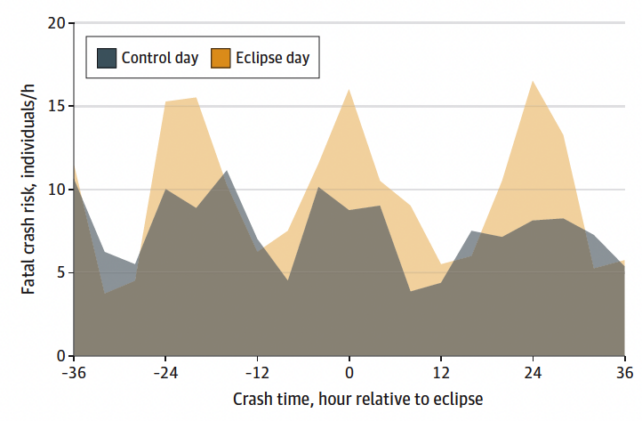Anticipation is building around April's solar eclipse. Not since 2017 have parts of the US been plunged into the all-consuming daytime darkness of a total solar eclipse; before that, it was 1979.
Weather permitting, Mexico's Pacific coast will be the first place to fall under the path of totality – when the Moon slips over the Sun, blocking its rays entirely for some lucky Earth observers.
From there, Texas up to Maine and out to the Atlantic coast of Newfoundland, Canada will slide into an eerie darkness that makes people feel the movement of Earth – just a small rocky planet sweeping through space in an intricate dance with other celestial objects – like never before.
So disorientating is the feeling of totality, and the buzz about it, that it might also wreak havoc on drivers: A new study has found fatal road accidents spiked in the US during the 2017 solar eclipse.
An estimated 20 million people traveled away from home in the US to catch a glimpse of the Sun's disappearing act that year. This led to bumper-to-bumper traffic on roads leading to and from the path of totality; congestion on some interstate routes lasted up to 13 hours after the main event, totality, which transpired in less than three minutes in any one place.
Similar traffic jams are expected across North America for April's event, with the biggest travel delays expected after the eclipse when everyone heads home.
Concerned for people's safety, two Canadian physicians studying traffic injuries, Donald Redelmeier of the University of Toronto and John Staples of the University of British Columbia, crunched the numbers on how many deadly road crashes occurred around the 2017 eclipse.
Using a national registry of fatal US road accidents, the pair tallied up fatal incidents that occurred on public roads during a three-day window centered on the 21 August 2017 eclipse.
Compared to a three-day period a week before and after the event, and controlling for the day of the week, fatal crashes increased around the time of the eclipse by about 30 percent.
Around 10 fatal accidents occurred per hour on the day before, the day of and day after the eclipse, compared to roughly 8 road fatalities per hour during the control periods.
"In absolute terms, this averaged to one extra crash-involved person every 25 minutes and one extra crash fatality every 95 minutes," Redelmeier and Staples write in their paper.
The relative risk of being in a fatal crash was 70 percent higher than usual for young people, and 40 percent higher than on normal clear weather days. The odds of being in a serious, but not fatal, road accident were also twice as likely around the 2017 eclipse.

While the eerie arrival of daytime darkness does strange things to animals attuned to day-night cycles – bees stop buzzing, bats appear and spiders pack up their webs – the reasons for these traffic accidents are likely much more mundane, the researchers suspect.
Driving on unfamiliar routes, speeding to reach the path of totality on time along roads possibly not designed for such large vehicle numbers, or being swept up in the excitement of such a rare celestial event could all explain the jump in road fatalities.
Driving while intoxicated or viewing the eclipse from hastily parked, unsafe roadside positions might have also been factors in those deadly accidents.
As excitement builds, the findings are a sobering reminder to take it slow on the roads and drive safely for those making the pilgrimage for April's event.
Just don't forget to pack your special eclipse glasses before you hit the road, to protect your eyes.
The study has been published in JAMA Internal Medicine.
